We first talked about counters way back in January. By April, we had narrowed it down to quartz. In May, we put together this materials palette to see how everything would work together. We then gathered all of our whitish quartz samples and landed somewhere in between white-white and speckly white.
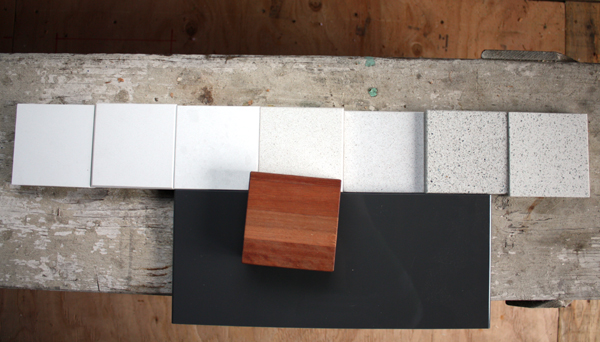
We thought we had found a winner in Eco quartz, but word to the wise, always look at a full size application of the material if you can. We happened to see a demonstration kitchen at IKEA a few months ago that used the Eco in our favorite color, “polar cap”, and were surprised to find that we didn’t like it. Part of the recycled content that goes into the material are tiny pieces of mirror which made the whole thing very glittery. Fortunately, there is a very similar Silestone product (Silestone and Eco are both owned by the same parent company) that doesn’t have the glitz (and it’s cheaper!). And even though it may not have as much recycled content as the Eco, they’re both coming from overseas and the Silestone will last just as long as the Eco, so it wasn’t a hard decision to make.
One decision down, on more to go. For the island, we were all set on offsetting the more expensive quartz with crazy cheap IKEA butcher block. Unlike other counter options that come in standard 25″ widths, the IKEA product comes in pieces up to 39″x72″. This didn’t leave us much overhang for barstools, but at $200, we could make it work. So a few weeks ago I went down to make the purchase…and when I went to look at the samples one more time (we were pretty sure about beech but I wanted to double check the other options), it just didn’t look as good. We have an IKEA butcher block as a work surface in the shop and as a large cutting board in our make-shift kitchen, and both of the those pieces seem to have narrower strips of wood than what I saw at the store. Maybe IKEA changed their design? Or maybe I’m just seeing things? Anyhow, I figured it was worth one more round of searching and mulling.

After much lunch-time research, these are the conclusions we made: butcher block of various species and sizes is not hard to come by, but it is expensive. I called up Ecohaus and the best they could offer me was side grain fir (at about $35/sf), but it was still more than we wanted to spend and since fir is a softwood, I was worried that it would get beat up pretty quickly. I even contacted Urban Hardwoods and Meyer Wells, two local companies that deal with reclaimed lumber. Meyer Wells said they were doing some butcher blocks out of reclaimed glulams, but for about $80/SF. Boo. We had found some nice lyptus butcher block at Crosscuts (same place we got our teak and teak plywood for the bathroom) a while back, but the largest width was 36″ which wouldn’t work. (We found out that we could order larger sizes but the special order and freight shipping proved to be cost prohibitive.) And then the “ah-ha” moment…buy two 25″ slabs of lyptus and biscuit them together. The lyptus (pictured above) is a gorgeous red-brown color that is extremely durable and about $20/SF. Plus, Kyle gets to use his new biscuit joiner again. Score!
Hardware! Where to start? How to decide? Since we’re doing mostly drawers for our base cabinets, it made sense to do a drawer pull rather than a knob or bar. We used an aluminum pull by Epco for our bathroom vanity (IKEA has some that are similar). They are affordable and look good, but we were worried that the kitchen hardware would see more abuse over time and the aluminum pull might not be up for the challenge. So we went into hardware research mode again, scouring the interwebs and our local hardware store to see what the world had to offer. But deep in our hearts, we knew we had already found the perfect drawer pull. And this is where the champagne taste, beer budget dilemma comes into play.
This pull is from Reveal Designs, a collaboration of architects and designers producing high quality, swoon-worthy hardware and furniture. Our favorite, aptly named the “Washington Pull” was designed by Cutler Anderson Architects, a well-known starchitect of the Pacific Northwest. Ok, it’s a bent piece of stainless steel…but unlike most other pulls, the ergonomics are right and the design is graceful. A few challenges – because of the thicker gauge of the steel (vs. aluminum options) this pull can’t be fastened to the top of the drawer/door face, which means we need to router out a small notch for it to recess into it. I was a bit skeptical of how we could router into the high-gloss finish, but fortunately I am married to Mr. Kyle Zerbey who simply designed and fashioned a custom jig to the do the job. The other challenge – price tag. These puppies run about $18 each (for the 3 1/2″) and $15 (for the 2 1/2″). And that’s after the architect discount. So we did some more research, but in the end we came back to the Washington pulls. Our logic – they’re durable, will withstand the daily abuse of a high-traffic area and they make us happy. I know, a drawer pull makes us happy.
The drawer pull solves about 80% of our hardware needs, but we still needed to pick out something for the three upper cabinets and the tall pantry. We opted for the (more affordable) bar pull from Epco. They’re simple and match the pull on our dishwasher. We especially like the smaller “T” pulls. Last but not least, we also picked up a new doorstop for the front door. It’s a sexy floor-mounted stop from Reveal Designs. A thick rubber disc around a stainless steel bar. Simple and effective.
The quartz counters go in next Thursday(!) and we’ll pick up the lyptus on Monday. My sisters are coming to town next weekend for my b-day and we are racing to get as much done as possible! So please, if anyone talks to the painting fairy, please send her to our house!
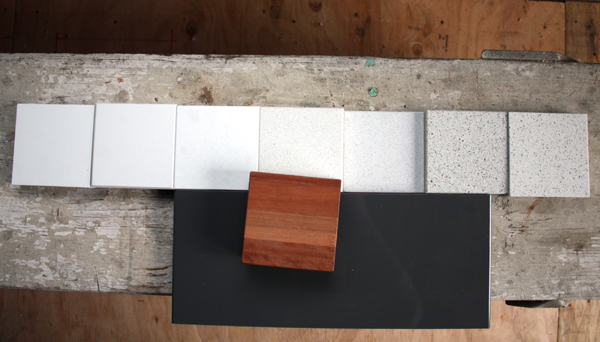
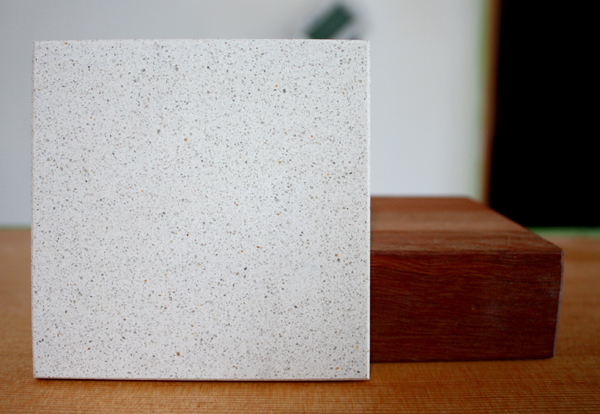
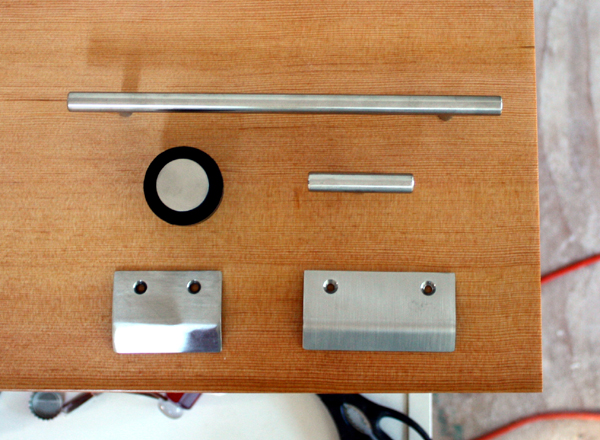

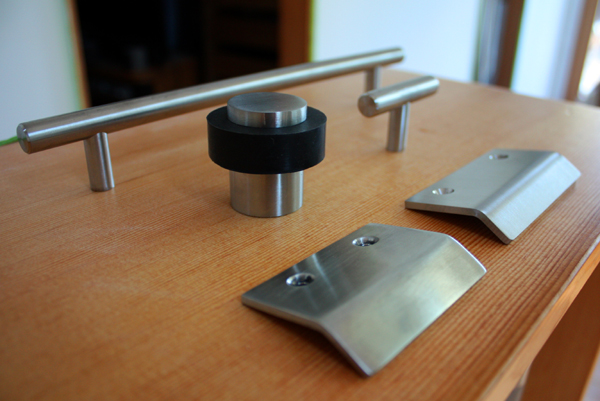
Love your selections! I was just debating pulls and countertops recently and dealing with some of the same issues you were. That’s just another reason why I love your blog!
Unfortunately I don’t have a Kyle, so I had to go with the thinner aluminum pulls and I’m just hoping they stand up to abuse. I’m even using it on a dw with a panel and am a bit nervous about that.
What is the Silestone color you selected? I’m still going back and forth between Silestone white zeus and Caesarstone blizzard.
Is the counter color Blanco Maple? If so, that’s what I used and I can send you photos if you want to see what a 7 foot run looks like.
Even being an Artist for decades, it still amazes me how much difference there can be from the “drawing pad to the podium”. I learned the hard way, and sometimes expensive way, to “broaden the scope”. I’m glad ya’ll caught this before!
Keep up the good work!
Teragren Chestnut is what we purchased for our peninsula countertop choice. I have not seen it yet but i ordered it anyways. We used Terrazzo countertop but if I had to pick again I would pick something else. Good work guys
http://www.teragren.com/products_countertops_strand.html#
I can be a painting fairy. 🙂 Can’t wait to see you guys!
haha, painting should finally be done tonight, except for the loft but that can wait a bit if it needs to. looking forward see you guys
It’s “white north”, but pretty similar to the Blanco Maple (we grabbed a sample of that one too). Goes in on Thursday…really hoping we like it!
Hey Laura, we’re going with the color “white north”. It’s pretty amazing how many different whites there are!
Hey guys. We have the T pulls and the bar pulls in our kitchen and they work great. We also have IKEA’s thin L shaped pulls (drastically cheaper and lower quality version of the Reveal design) on the uppers. The T pulls have worked great for the most part, though with Lana in the house, they do get knocked out of level on occasion and for that reason I wouldn’t use them again. Still, it’s a minor problem and they’re good quality. I think they’re Epco too….solid, not hollow.
That Reveal hardware sure is nice! Good choices. I think they’re worth the money, btw.